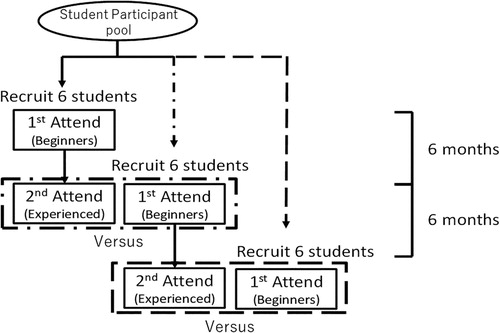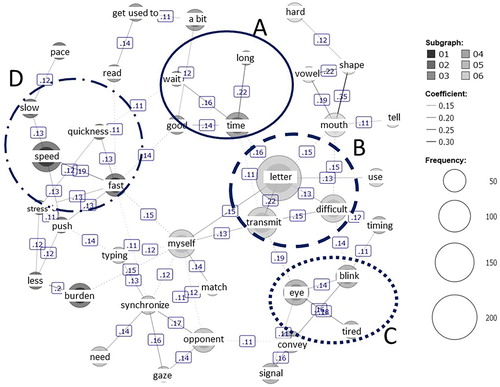Figures & data
Table 1. Program outline.
Figure 1. Study design: a waiting-list control design.
Notes: This figure shows the flow of the study at one university. Here, implementation was conducted with one group of six participants at one university (The full study was conducted at four universities using the same flow). All participants, except for those in the last group, completed the same program twice at 6-month intervals. The effect of the education program was evaluated by comparing the outcomes between the first attendance (Beginners) and second attendance (Experienced).

Table 2. Correct answer percentage for each question in the pre-test/post-test.
Table 3. Mean pre-test/post-test scores for each group.
Table 4. Number of letters transmitted in a 5-minute period for each AAC system by group.
Table 5. VAS change rates by AAC.
Figure 2. Co-occurrence network.
Notes: The figure was created with KH Coder® based on the frequency and pattern of words in free-text comments, without consideration of the analysts’ intentions. Words with strong co-occurrence were arranged close together and connected with lines. Circle sizes corresponded to the frequency. The numbers on the lines indicated the Jaccard coefficients. Larger values suggest a stronger degree of co-occurrence. Words reflecting feelings of burden were separated into ‘time burden’ (circle A), ‘technical burden’ (circle B), and ‘eyestrain’ (circle C). The other group (circle D) directly reflected burden relating to ‘speed’.

Table 6. Coding table of the four extracted concepts.
Table 7. Difference in the number of coded concepts between the groups.
Data availability statement
Ishikawa T, Narita Y, Fukuroku K, Takahashi E, Mizumoto C. Gross numbers of letters as the effect of a short-term training program for augmentative and alternative communication on health-care students after 6 months. Amyotroph Lateral Scler Frontotemporal Degener. 2019;20(sup.1):340.
